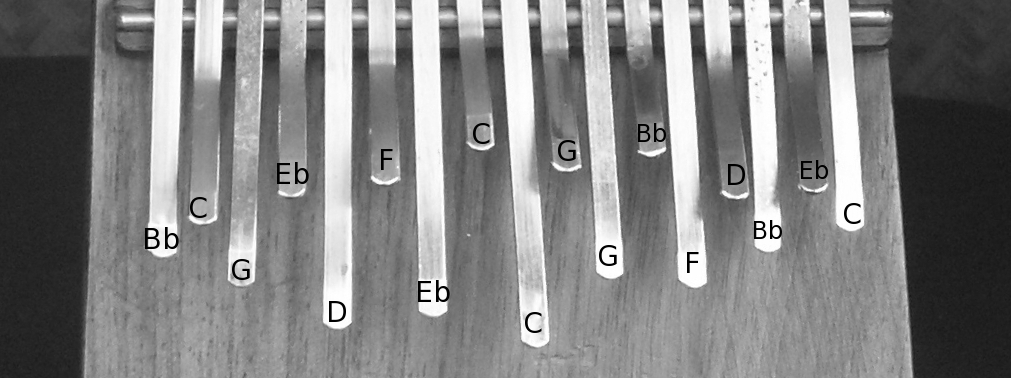The Lotus-tuned karimba was created by the inventive recording artist SaReGaMa. He once received an out-of-tune African-tuned karimba as a gift. Rather than simply tuning it up, SaReGaMa instead used this as an opportunity to invent several of his own tunings and create music that worked with each tuning. The Lotus tuning is the one he used for a song that he improvised one night in an effort to get his baby daughter, Lotus, to go to sleep. He made a video of that improvisation, known to the world as “Kalimba Solo for Lotus.”
Available at the Kalimba Magic Shop, we have two instructional downloads and one book for the innovative Lotus karimba tuning. In this post we are giving away the tablature for Exercise 20, “Three Trills,” from the book Playing the Lotus Karimba. A trill on kalimba happens when you have two notes that are exactly the same on both the left and right sides of the kalimba, and you play them quickly, alternating between them. Listen to find out exactly what this sounds like!

Trills are made by playing redundant notes fast in an alternating fashion. To explain this, look at the tuning illustration for the Lotus, where you can see four pairs of redundant notes – notes are redundant when there are more than one of a particular note on an instrument. On this karimba the redundant notes are G, Bb, C, and Eb. In each case, one of the redundant notes is on the left side of the instrument and the other is on the right (although sometimes redundant notes appear on the same side of a kalimba).
The Lotus-tuned karimba has four C notes. One of them is very low and one is very high, and because they are of different pitches, they are not redundant. But the C’s on the far right and far left are the same length, and are thus the exact same pitch, which makes them redundant notes. By playing two redundant notes alternately and fast – left-right-left-right, etc. – you are playing a trill.
Click to download PDF of tablature. You will notice that the note names are also listed at the foot of the tablature. The letters to the right of the tab indicate the note of each trill. If you download the PDF file, open it on your computer and click on the title and your web browser will be directed to play the MP3 file!
The song above utilizes trills on the C, the Eb and the Bb. This entire song has a strictly alternating right-left pattern – the only deviation from that rule is in measures 2 and 4 where you can see two left-side notes in a row. The first of those pairs is a long note (quarter note), and there is a kind of gap in between it and the eighth-note that follows it – in other words, an auditory “space” exists (which everywhere else is filled with a right-side note). And even though there are two left-side notes in a row (sometimes a challenging arrangement), this is natural and easy to play. And, in addition to being easy to play, leaving out the right-side note makes the music syncopated and cool. This is a general rule of thumb – you can create syncopation by just leaving out a downbeat note played by one thumb in an otherwise strictly alternating left-right sequence.
Which brings us to another point: The notes in measures 1 and 3 are all C’s, on both right and left sides. But in the recording you hear on this page (see the audio player at the bottom of the post), I repeat the entire 4-measure song five times, and on the third and fourth repeats you will hear that I leave out one of those C notes. This creates syncopation in the exact same way we discussed (and is actually written) in measures 2 and 4.
Leaving out a note or two is a great way to create your own variations. Experiment with this. If you leave out only one note, there are 22 different variations you can make. If you leave out two notes anyplace in this exercise, you can make 231 different variations!
Now, instead of leaving out a note completely, you could play around with making a note louder or softer here and there. Accents – playing one or more notes louder than the others – is also a great way to add subtlety and interest to music. Since there are many “shades” of volume you can use, this can result in many more subtle variations.
Experiment! Try different things! And above all, attend to what you’re doing, so when you hit on the one that says exactly what you feel, you can do it again, and hopefully even remember it for tomorrow.
One more tweaky thing about this music: C is the only redundant note-pair that has one note on the lower row and the other note on the upper row. Measures 1 and 3 are therefore half upper and half lower. Measure 2 is all upper notes (represented by gray columns in the tab) and Measure 4 is all lower notes (represented by white columns). In other words, there is some sort of balance between the upper notes and the lower notes, sometimes going up and sometimes going down, a bit like Yin and Yang.
If this post was useful to you, much more about this karimba can be had by purchasing a Lotus book or instructional download which include dozens of tablature exercises, tips, lessons and techniques. Check them out in the links below!


Sign up for our newsletter and free resources with your email address:
We pinky promise not to spam you and to only send good stuff.
 Christmas in July 2025
Christmas in July 2025 Patriotic and American Music for Kalimba
Patriotic and American Music for Kalimba